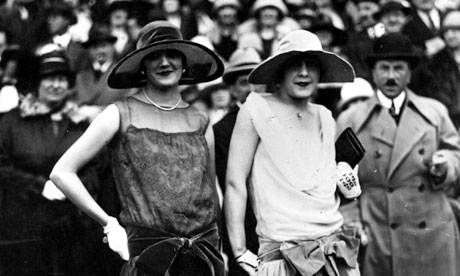
Going on a diet in January is what we are supposed to do, along with feeling guilty about credit card bills and anticipating summer holidays. It is the way in which the natural function of eating has become wedged into an artificial cycle of anticipation, indulgence and penance, Louise Foxcroft says, that makes the whole business such a sick one. We are set up to falter and fail and start again, getting fatter with each turn of the year. Meanwhile, the peddlers of diet books, supplements and DVDs grow sleek on our misery.
Still, that's no reason not to try to wring some fun – and a book – out of it. Calories & Corsets is a brisk jog through the ways in which women, and men too, have attempted to imagine and regulate their bodies from ancient times to the present. Given that Foxcroft wraps it all up in 200 pages, this is not intended as an account of great depth.
Foxcroft's breezy style, spiked with the occasional outraged squeak at the pity of it all, allows her to embed entertaining case histories in a loosely chronological narrative. There is Byron, the most famous serial dieter of them all, who managed to transform himself from a bit of a porker into the satisfactorily attenuated shape required of a Romantic poet. He sipped vinegar, slurped pap and, of course, swam the Hellespont which must have burnt up 4,000 calories in one go. Still, no matter how slender he got, m'lord still retained the exacting eye of the chronically eating disordered. Chased around London by Caroline Lamb, whom no one could accuse of being either sane or pleasingly plump, he shrieked that he was being stalked by a "skeleton".
Lady Caroline, then, had committed that other great dieting sin of being Too Thin. It was an accusation that was to be levelled at a whole generation of women in the 1920s. On the one hand doctors awarded the post-first world war generation metaphorical gold stars for having weaned themselves off the bustled bottoms and pouter-pigeon chests of the previously deforming age. But now it looked as though this cohort of small-hipped, flat-chested, crop-haired chits was trying to replace all those young men who had been lost on the Western Front. Get any thinner, said the doctors, peering metaphorically over their half-moon spectacles, and there was a good chance that they would all turn into lesbians.
This stuff is battily fun, but Foxcroft does more than simply string anecdotes together for comic effect. She is, for instance, particularly good on the genealogy of diets. Take the Hay diet of the early 20th century. Contrary to what some contemporaries thought, this didn't involve eating dried grass, but decreed instead that you consume your proteins, fats and carbs at separate sittings. All nonsense of course, but Henry Ford swore by it. Tweaked just a little, this monotrophic regime became the all-conquering Beverly Hills Diet of the 1980s. In much the same way, the high-protein Atkins regime which swept all before it in the late 90s, has recently been rejigged, given a seductive French accent, and now shifts masses of product as the Dukan diet.
The Hay, Atkins and Dukan programmes all benefit from the important "Dr" prefix, which gives a reassuring stamp of approval, regardless of whether the science holds up. If you don't want to put your faith in clever men, however, you could always try God. One of the most amusing sections in Calories & Corsets concerns the fundamentalist weight loss movement that flourished during the 60s and 70s in the States. At that time you could take your pick from such soulful approaches as "I Prayed Myself Slim", "More of Jesus, Less of Me" and "Help Lord: the Devil Wants Me Fat". And yet this approach identified what the heathen majority is still struggling to believe: that fatness is the result of what happens inside your head as much as your stomach. Take God out of the equation and substitute what used to be called the patriarchy and you have Susie Orbach's Fat Is a Feminist Issue, a book at which it would still be considered rude to snigger.
This endless short-circuiting shows how slippery any discussion about the diet industry always becomes. You may start off with the best of intentions, determined merely to describe rather than judge how people have historically tried to manipulate their shape. But before you get very far you find yourself compromised. Indeed, three quarters of the way through the book Foxcroft stops piling up the stories – the fat man whose coffin had to be rolled through the town on wheels, the European empress who wouldn't eat if her waist went beyond 19½in – and starts to sound as if she is employed by a health charity to promote sensible weight loss.
In one sense there's nothing wrong with this. You'd be silly (though silly in a normal sort of way) if you thought that a crash diet was the means to physical and psychological happiness. But so pervasive is our diet culture, as well as our anti-diet culture, that Foxcroft never questions whether the "eat sensibly/exercise moderately/think long-term" approach is not in fact simply another cultural specific dressed up as an enduring truth. For what this entertaining book unwittingly reveals is that you cannot write a popular history of dieting without becoming part of the murky industry you are trying to critique.
• Kathryn Hughes's The Short Life and Long Times of Mrs Beeton is published by Harper Perennial.

